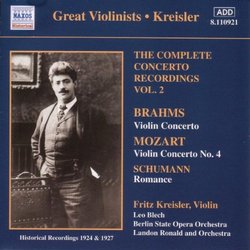| All Artists: Kreisler, Brahms, Mozart, Schumann, Blech Title: Great Violinists: Kreisler Compl Cto Recordings 2 Members Wishing: 0 Total Copies: 0 Label: Naxos Original Release Date: 1/1/2024 Re-Release Date: 11/14/2000 Genre: Classical Styles: Chamber Music, Forms & Genres, Concertos, Sonatas, Historical Periods, Classical (c.1770-1830), Modern, 20th, & 21st Century, Instruments, Reeds & Winds, Strings Number of Discs: 1 SwapaCD Credits: 1 UPC: 636943192122 |
Search - Kreisler, Brahms, Mozart :: Great Violinists: Kreisler Compl Cto Recordings 2
 | Kreisler, Brahms, Mozart Great Violinists: Kreisler Compl Cto Recordings 2 Genre: Classical
|
Larger Image |
CD Details |
CD ReviewsA Valuable Reissue Matthew Davidson | Houston, TX United States | 05/19/2002 (4 out of 5 stars) "How to describe Kreisler's playing? Just as Furtwangler is often contrasted to Toscanini, it is perhaps instructive to imagine Kreisler as the almost exact opposite of the violinist who largely supplanted him, Jascha Heifetz. Heifetz' speeds tend to be faster, the tempo more unyielding, his vibrato tighter and more restrained, and his interpretations more classical and aristocratic (sometimes tending towards cold). To call his playing schmaltzy probably does Kreisler a disservice, but it is undeniable that he often flirts with the vulgar. His frequent use of obvious and unsubtle rubato to shape the musical lines and frequent portamento effects are not to everyone's tastes, and there is, of course, his famous ever-present vibrato (even on many eighth notes), used to particular effect in the double-stopping. Overall the tone is rich and warm.The Mozart is played in a style that would be inconceivable today, with long, obvious rallentandos and the warm, Viennese style that was Kreisler's trademark. The use of tubas instead of double basses is also very evident (the basses would not register on the old acoustic recordings), sounding very much like one would expect tubas to sound in Mozart. The andante in particular is ravishingly romantic in a way that most modern listeners do not normally associate with Mozart. An acoustic recording from1924, there is a lot of surface noise, but the soloist is captured well (even if the orchestral accompaniment is, at turns, muddy and occasionally brittle).The 1927 Brahms recording is, in my opinion, a much more important historical document. Kreisler's unabashedly warm style is well-suited to this concerto, particularly exciting in the first movement. Although the Berlin State Opera Orchestra under Blech is occasionally a little heavy handed, Kreisler brings insights to this work that simply cannot be found anywhere else (one is tempted to recall that Kreisler knew and had played for Brahms himself as a young man). Kreisler consistently shapes his phrases with such authority and rhapsodic beauty of tone that one never questions his judgment. Although there is still surface noise, it is largely unobtrusive and both the violin and the orchestra emerge truthfully (with the balance favoring the soloist).The Schumann is a filler played in the parlor style immediately recognizable to anyone familiar with Kreisler's recordings of his own violin compositions. Speaking as someone whose time and budget constraints would normally dictate the acquisition of multiple recordings of a work as somewhat indulgent, this one is well-worth adding to your collection even if it is not a primary recommendation. For students of violin technique and lovers of the Brahms Concerto this one is indispensable, especially considering the bargain price. Five stars for the Brahms, four for the Mozart with the "vintage" sound averaging down the overall score to a four."
|

 Track Listings (7) - Disc #1
Track Listings (7) - Disc #1